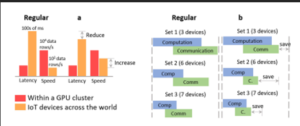Assignment Sample on Review on Towards Distributed, Global, Deep, Learning Using IOT Devices
INTRODUCTION
According to Bharath Sudharsan in their study, they highlighted the research challenges for globally distributed Deep Learning training and classification. It utilizes decentralized training on numerous IoT devices as opposed to the conventional method, which loads such information and trains models exclusively inside a GPU cluster or even database servers. Using massive, high-quality IoT datasets for deep learning (DL) might be operationally intensive. A sustainable distributed learning system is necessary to use such datasets to create a problem-solving models in a suitable amount of time. Instead of using the GPU cluster that is accessible inside a data center, this article presents a novel strategy that involves training one DL model upon that architecture of thousands of mid-sized IoT nodes throughout the world. It analyses the model’s durability and model integration, identifying three inefficiencies: expensive computational processes, time-consuming information loading I/O, and the slow interchange of model variables. It considers a case report out from video data computing sector to illustrate research problems for highly dispersed DL classifying and training. That requirement for a two-step deep compression technique that accelerates training and scales DL training processing is also described. The presented approach is able to increase the resilience of the decentralized training procedure to fluctuating data throughput, congestion, and the standard of service metrics, according to the preliminary operational results.
This article suggests the bottleneck analysis for situations involving globally spread DL model training in the segment “Distributed Global Training: Research Challenges.” It replied to the problems mentioned in Part “Distributed Global Training: Research Challenges” found in the chapter “Proposed two-step Deep Compression Method and Initial Experimental Results.” The portion ends by laying forth a broader context for future investigation. The live model-compressing while training can be enhanced using a two-step procedure proposed in this study, without changing the DL model structures or the model’s accuracy. Our two-step deep reduction approach attempts to boost scaling and training speed simultaneously. By sparingly broadcasting just the crucial gradients, the first stage, in particular, tries to accept variations in real-world delay and traffic constraints. By selectively gathering gradients, the second phase seeks to lower the communication-to-computation ratio and increase scalability. Just after exceeding the gradient limit are transmitting and encoding operations performed. Each of the following steps is described in the remaining portion of this section.

Figure: Comparing distributed training within a GPU cluster versus training using geographically distributed IoT devices
In the first stage, it uses gradient intensity as a straightforward heuristic to determine the significant gradients, while users can optionally pick different choosing criteria. To ensure that the data is retained, these significant gradients are locally accumulated. That is because the training process may tolerate delay; this step lowers the gradient synchronizing regularity by preventing the transmission of all gradients. The dynamic real-world delay is not reduced since it is extremely difficult to do so. Consequently, training can be scaled up more easily, allowing more IoT systems to participate and train at faster rates. The second phase involves encoding the gradients and transmitting them to further participating devices engaged in the training phase or to the parametric server after the criteria for the aggregated gradients is exceeded. This phase increases sustainability by lowering the transmission to computing ratio by delivering all the crucial gradients only if necessary and not at predetermined frequencies. In a summary, both stages accumulate, encode, and sparsely communicate just the significant gradients while in order to strengthen training efficiency and sustainability.
Under this research, it described a method for worldwide training DL algorithms on idle IoT nodes. The suggested approach enables decentralized training of operationally expensive model on scattered idle IoT devices, which may be utilised to integrate DL frameworks running on wide scale assets with suggestions from the TinyML community. TinyML and various techniques frequently presume that models is built in a data center and only perform inferences on IoT Connected systems. The presented concept can be used in conjunction with TF-Lite as well as Federated Learning methods and can substantially reduce gradients even during training of a variety of NN frameworks, including CNNs and RNNs, providing the foundation for a wide range of decentralized and participatory learning uses.
Future Scope
It is clear from the study that scaling is crucial when integrating a significant number of objects. The interaction intensity, where the transmission cost is defined by networking capacity and latencies, requires to be greatly reduced in order to increase scaling. Since there is typically no delay between systems in a data center or between GPUs in a cluster, all standard research concentrates on lowering the bandwidth needs. The two-step deep compression strategy that is discussed seeks to boost extensibility and mentoring speed at the same time. By sparingly broadcasting just the crucial variables, the first stage, in especially, tries to accommodate variability in actual latency and capacity constraints. By locally aggregating gradients, the second phase seeks to lower the interaction proportion and increase scaling. Then after exceeding the gradient barrier are transmit and encoding operations performed.
Know more about UniqueSubmission’s other writing services:


Its like you read my mind! You appear to know so much about this, like you wrote the book in it or something. I think that you can do with a few pics to drive the message home a little bit, but instead of that, this is excellent blog. A fantastic read. I’ll certainly be back.